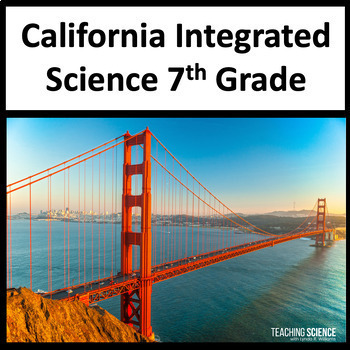California Integrated Model 7th Grade NGSS Full Year Science Lessons & Labs
- Zip

What educators are saying
Products in this Bundle (20)
showing 1-5 of 20 products
Bonus
Description
This is a bundle for 7th Grade: NGSS Integrated Model. This bundle covers the PEs and standards for NGSS for 7th grade in the California Preferred Integrated Model. Purchase of this bundle will save you 20% on these science resources. If you teach 7th grade in California, you need this bundle.
This Integrated Science Model Bundle for Seventh Grade Includes:
- Lesson Plans
- Labs
- Follow-up pages
- Notetaking
- reading passages
- Answer Keys
- more
The resources in this middle school science bundle include:
+Molecules to Organisms: Structures and Processes
+Ecosystems: Interactions, Energy, and Dynamics
- Ecosystems: Patterns of Interactions MS-LS2-1
- Ecosystem Food Web Unit
- Cycling of Matter and Flow of Energy
- Evaluate Competing Designs for Maintaining Ecosystem Solutions
+Earth’s Systems
+Earth and Human Activity
+Matter and Its Interactions
- Molecules
- Chemical Reactions
- Synthetic Materials
- Thermal Energy and Particle Motion
- Exothermic and Endothermic Reactions
+Engineering and Design
- Assessments- California Integrated Model Assessments 7th grade
- Jeopardy-style review game in Google Slides
Teachers Love this Integrated Science Bundle!❤️❤️❤️
Bright Light ⭐️ ⭐️ ⭐️ ⭐️ ⭐️ Extremely Satisfied
I was in need of help and this was extremely helpful. As a new teacher I was struggling lesson planning every night. I was hesitant at first because I've never bought anything this big on TPT but it's worth it! It has engaging activities for students and the lessons are easy to follow. The lessons also align with the science standards I teach so thats a plus. Thank you for this great resource!
Alisha ⭐️ ⭐️ ⭐️ ⭐️ ⭐️ Extremely Satisfied
This is great for teaching the California integrated model for 7th grade. It covers all of our standards and includes a variety of activities.
Standards Addressed
MS-LS1 From Molecules to Organisms: Structures and Processes
MS-LS1-6. Construct a scientific explanation based on evidence for the role of photosynthesis in the cycling of matter and flow of energy into and out of organisms.
MS-LS1-7. Develop a model to describe how food is rearranged through chemical reactions forming new molecules that support growth and/or release energy as this matter moves through an organism
MS-LS2-1. Analyze and interpret data to provide evidence for the effects of resource availability on organisms and populations of organisms in an ecosystem.
MS-LS2-2. Construct an explanation that predicts patterns of interactions among organisms across multiple ecosystems.
MS-LS2-3. Develop a model to describe the cycling of matter and flow of energy among living and nonliving parts of an ecosystem.
MS-LS2-4. Construct an argument supported by empirical evidence that changes to physical or biological components of an ecosystem affect populations.
MS-LS2-5. Evaluate competing design solutions for maintaining biodiversity and ecosystem services.*
MS-ESS2-1. Develop a model to describe the cycling of Earth’s materials and the flow of energy that drives this process.
MS-ESS2-2. Construct an explanation based on evidence for how geoscience processes have changed Earth’s surface at varying time and spatial scales.
MS-ESS2-3. Analyze and interpret data on the distribution of fossils and rocks, continental shapes, and seafloor structures to provide evidence of the past plate motions.
MS-ESS3-1. Construct a scientific explanation based on evidence for how the uneven distributions of Earth’s mineral, energy, and groundwater resources are the result of past and current geoscience processes.
MS-ESS3-2. Analyze and interpret data on natural hazards to forecast future catastrophic events and inform the development of technologies to mitigate their effects
MS-PS1-1. Develop models to describe the atomic composition of simple molecules and extended structures.
MS-PS1-2. Analyze and interpret data on the properties of substances before and after the substances interact to determine if a chemical reaction has occurred.
MS-PS1-3. Gather and make sense of information to describe that synthetic materials come from natural resources and impact society
MS-PS1-4. Develop a model that predicts and describes changes in particle motion, temperature, and state of a pure substance when thermal energy is added or removed. [MS-PS1-5. Develop and use a model to describe how the total number of atoms does not change in a chemical reaction and thus mass is conserved.
MS-PS1-6. Undertake a design project to construct, test, and modify a device that either releases or absorbs thermal energy by chemical processes.*
MS-ETS1-1. Define the criteria and constraints of a design problem with sufficient precision to ensure a successful solution, taking into account relevant scientific principles and potential impacts on people and the natural environment that may limit possible solutions.
MS-ETS1-2. Evaluate competing design solutions using a systematic process to determine how well they meet the criteria and constraints of the problem.
MS-ETS1-3. Analyze data from tests to determine similarities and differences among several design solutions to identify the best characteristics of each that can be combined into a new solution to better meet the criteria for success.
MS-ETS1-4. Develop a model to generate data for iterative testing and modification of a proposed object, tool, or process such that an optimal design can be achieved
Please note, that my resources are not editable for copyright reasons. Resources are in pdf and ppt format.
These resources are created by Lynda R. Williams at Teaching Science
Follow me and get news of my new resources. Each new resource is discounted by 50% for the first 24 hours!
See more about my expertise on California NGSS on my website.
Get this great companion piece to your science bundle:
You will love these bell ringers for middle school science





